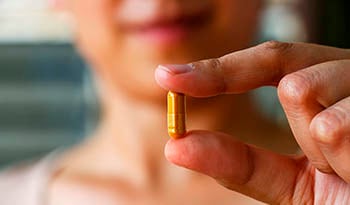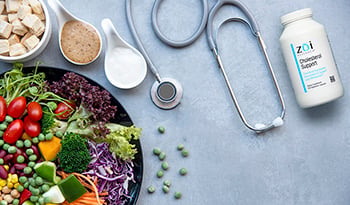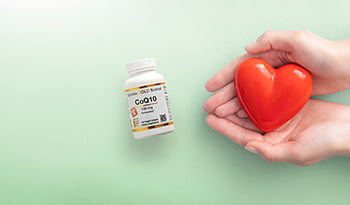How’s Your Circulation? How to Check and Support Your Circulatory Health
DISCLAIMER:This blog does not intend to provide diagnosis...
- In this article:
- How Does the Circulatory System Work?
- What Are Signs of Poor Circulation?
- Ways to Improve Your Circulation
- Consider Supplementation

Your circulatory system plays a vital role in not just your general health, but your very survival as well. It brings oxygen and nutrients to your body’s tissues and organs. It also transports waste and toxins for elimination.
How Does the Circulatory System Work?
Your body’s circulation is comprised of different systems.
- The cardiovascular system is made up of the heart, blood, and blood vessels. The heart acts as a pump, pushing blood through your vessels. Arteries are the vessels that carry blood away from your heart while veins carry blood back to the heart. Connecting these two types of vessels are capillaries. The walls of these tiny blood vessels are thin enough for waste, toxins, oxygen, and nutrients to pass through, either to or from surrounding tissues.
- The lymphatic system serves multiple functions. It maintains your body’s fluid levels, collecting excess fluid from your tissues and returning it to your bloodstream. As part of your immune system, it protects your body as well. Other roles include waste removal and fat absorption.
There is an extensive network of tissues, organs, lymph nodes, and lymphatic vessels that make up the lymphatic system. Lymph fluid drains from your body’s tissues and into your lymphatic vessels for transport to lymph nodes. These nodes can filter waste products and other harmful substances. Additionally, white blood cells within the nodes can also attack cancer cells or infectious organisms. After passing through the nodes, lymph is carried to your bloodstream, entering it at your subclavian veins.
What Are Signs of Poor Circulation?
When you don’t have good blood or lymph circulation, there are various signs and symptoms that may occur. Do a self-check. Determine if any of the following conditions are present in your case. You may need to take further action to support your circulatory health. It could even be serious enough to seek the advice of a healthcare practitioner.
- Cold or painful limbs
- Numbness or tingling
- Fatigue
- Headaches, dizziness, or lightheadedness
- Brain fog
- Infections
- Slow or delayed wound healing
- Swollen abdomen or limbs
- Shortness of breath
- Skin changes, weeping, or discoloration
- Digestive problems
If you specifically have a problem with your lymphatic circulation, it could weaken your immunity and you may notice increased allergic reactions or frequent flu and cold symptoms. Additionally, if you have inadequate blood flow, you may experience muscle cramps, low libido, or increased pain when walking.
There’s a quick test you can do at home that may alert you to a possible blood flow problem:
- If you press your finger against your skin, you may note that it will blanch (or become pale).
- Upon releasing the pressure, the color should return to the skin within 3 seconds as the blood flow to the area becomes normal again.
- If color is slow to return, that’s suspicious for a problem with the circulation in that area.
This blanching test can also be done by pressing on a toenail or fingernail. If you have a dark complexion, blanching may not be useful for checking your blood flow.
Ways to Improve Your Circulation
There are many things you can do if you’d like to achieve and maintain a healthy circulatory system. To support a good flow of blood and lymph in your body, consider the following lifestyle habits and supplement options:
Stay Hydrated
Both blood and lymph have high water content. So to keep them moving through your body well, you need to maintain good hydration.
One sign that you are drinking enough water is a clear appearance in your urine. However, in order to avoid overhydration and disruption of your body’s electrolyte balance, it’s wise to get an estimate of your daily water requirement by drinking just up to the amount it takes to get your urine clear. Then back off that amount a bit until a pale color returns to your urine. Whatever amount of water gives you this pale color is a good goal for your daily intake.
Generally, a daily water intake goal measures anywhere from 0.5 to 1 ounce of water for every pound of body weight. For example, if you weigh 130 pounds, then you would aim to drink about 65 to 130 ounces of water each day. You may need to drink more in the case of illness, exercise, or hot climate.
Exercise Regularly
During physical activity, your muscles require more oxygen, so your heart works harder to move blood around your body. Arteries dilate (i.e. open up) so that more blood can flow, bringing the necessary oxygen to the active muscles.
Over time, regular exercise makes the heart stronger. It also reduces the stiffness of your arteries which lowers your blood pressure if you have hypertension (a high blood pressure condition). Thus, these effects on your heart and blood vessels reduce your risk for cardiovascular disease.
Additionally, the contraction and relaxation of muscles during exercise compresses the surrounding tissues which helps to propel lymph fluid through its lymphatic vessels. This maintains the filtration of lymph and prevents lymphatic congestion.
Manage Stress
When you experience a stressful situation, stress hormones like cortisol, epinephrine, and norepinephrine can increase. These hormones cause blood vessels to constrict (i.e. tighten). So your blood pressure typically increases when you’re under stress. In a study on 400 adults with normal blood pressure, researchers found that those who had higher measurements of stress hormone levels were more likely to develop hypertension over the next 6-7 years.
Thus, being consistent about finding ways to relieve your stress can help keep your blood pressure in a healthy range and reduce the strain on your heart. There is a wide variety of stress management techniques you can try. Yoga, meditation, and deep breathing are all great stress relievers. Laughter and making social connections can reduce your stress hormone levels as well. So reach out to some friends. Enjoy some jokes. Watch a comedy routine. Also important for stress management is getting adequate sleep. The average adult requires at least 7-8 hours each night.
Studies have shown that lavender aromatherapy is another effective stress reliever. Try adding 3 to 5 drops of lavender essential oil to 100 milliliters of water in a diffuser. Avoid inhaling the mist directly. It’s a good idea to set the diffuser at least 3 feet away from you.
Get a Massage
The experience of a massage can provide good stress management. But there is also the added benefit of the direct pressure placed on the tissues of your body, encouraging the flow of fluid in your circulatory system. Specifically, a lymphatic drainage massage can relieve any congestion of lymph that may be occurring.
There are some situations where a lymphatic drainage massage could be harmful. If you have a blood clot, heart failure, kidney failure, an active infection, active bleeding, undiagnosed cancer, or other medical conditions of concern to you, then it’s best to consult your health care provider prior to seeking this type of massage.
Eat a Healthy and Balanced Diet
Consume plenty of fruits and vegetables. Limit your intake of saturated fat (often found in red meat and many types of cheese). The American Heart Association recommends that no more than 5-6% of your total daily calories come from saturated fat. Avoid excess salt in your diet. According to the Dietary Guidelines for Americans, an average adult American should not consume more than 2,300 milligrams of salt each day. Following these dietary recommendations can help keep your cholesterol level and blood pressure in check.
There are also specific foods that can support healthy circulation. For those who have hypertension, garlic can reduce blood pressure. In fact, there is research that showed garlic’s effectiveness was comparable to some standard blood pressure-lowering medications. Another food that can benefit you is oily fish like salmon and mackerel. These fish contain polyunsaturated fatty acids called EPA and DHA that can lower your blood pressure and triglyceride level.
Consider Supplementation
Many people turn to supplements in order to ensure they are taking in the number of nutrients needed to achieve their health goals. If you wish to support your circulatory health, supplement options include the following:
- Nicotinamide riboside is a form of Vitamin B3 (also called niacin). It has been shown to lower blood pressure in those at risk for developing hypertension. Researchers have found that nicotinamide riboside also increases nicotinamide adenine dinucleotide (NAD+) levels. NAD+ plays a role in many physiologic processes like converting food into energy, repairing damaged DNA, protecting cells against stress, and maintaining your sleep-wake cycle.
- Iron is an important component of hemoglobin which is the protein responsible for carrying oxygen in your blood. Iron also plays a role in the creation of the connective tissue within blood vessel walls. According to the National Institutes of Health, adults should not take more than 45 milligrams of iron daily to avoid side effects like nausea, constipation, and abdominal pain.
- Hawthorn is an herb that has been studied for its effects on heart failure conditions. Studies have shown that symptoms of heart failure (like fatigue, palpitations, and shortness of breath upon exertion) improved in people who took hawthorn extract.
- Beetroot powder contains nitrate, which your body converts to nitric oxide. Nitric oxide helps your blood vessels to dilate which increases blood flow. A study revealed that patients with hypertension who drank beetroot juice experienced a reduction in blood pressure and a decrease in the stiffness of their arteries.
Remember, if you take medication or have a heart-associated condition, you should consult a health care provider before taking a supplement to support your circulatory system.
References:
- Nystoriak MA, Bhatnagar A. Cardiovascular Effects and Benefits of Exercise. Front Cardiovasc Med. 2018;5:135.
- Inoue K, Horwich T, Bhatnagar R, Bhatt K, Goldwater D, Seeman T, Watson KE. Urinary Stress Hormones, Hypertension, and Cardiovascular Events: The Multi-Ethnic Study of Atherosclerosis. Hypertension. 2021;78:1640–1647.
- Koulivand PH, Khaleghi Ghadiri M, Gorji A. Lavender and the nervous system. Evid Based Complement Alternat Med. 2013;2013:681304.
- Ried K. Garlic lowers blood pressure in hypertensive subjects, improves arterial stiffness and gut microbiota: A review and meta-analysis. Exp Ther Med. 2020;19(2):1472-1478.
- Bradberry JC, Hilleman DE. Overview of omega-3 Fatty Acid therapies. P T. 2013;38(11):681-691.
- Martens C, Denman B, Mazzo M, Armstrong M, Reisdorph N, McQueen M, Chonchol M, Seals D. Nicotinamide riboside supplementation reduces aortic stiffness and blood pressure in middle-aged and older adults. Artery Research. 2017;20:49.
- Habs M. Prospective, comparative cohort studies and their contribution to the benefit assessments of therapeutic options: heart failure treatment with and without Hawthorn special extract WS 1442. Forsch Komplementarmed Klass Naturheilkd. 2004 Aug;11 Suppl 1:36-9.
- Clifford T, Howatson G, West DJ, Stevenson EJ. The potential benefits of red beetroot supplementation in health and disease. Nutrients. 2015;7(4):2801-2822.
- Kapil V, Khambata RS, Robertson A, Caulfield MJ, Ahluwalia A. Dietary nitrate provides sustained blood pressure lowering in hypertensive patients: a randomized, phase 2, double-blind, placebo-controlled study. Hypertension. 2015 Feb;65(2):320-7.

 By Dr. Venus Ramos, M.D.
By Dr. Venus Ramos, M.D.


